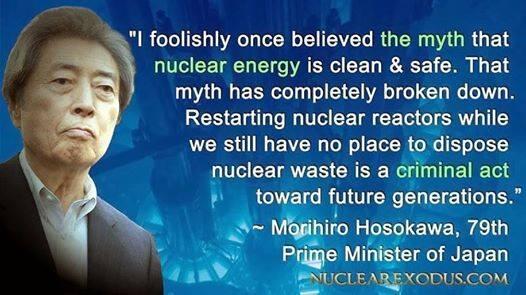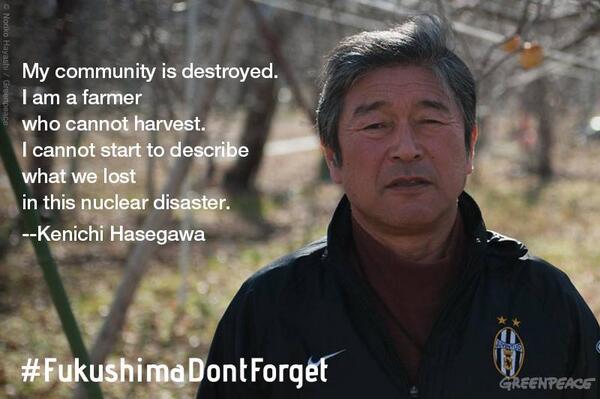Former NRC Chair Greg Jaczko asks if Japan is ready for another nuclear accident: “This has to be remembered—that there are certain accidents that are not preventable,” said Gregory Jaczko, former chairman of the U.S. Nuclear Regulatory Commission. “The question Japan has to ask itself is: Is the country willing to have another accident? And if the answer is no, then the answer has to be no more nuclear power.” In reality, the answer can only be no. No country in the world is prepared for a nuclear accident on the scale of Fukushima.

Japanese former Prime Minister Naoto Kan was a nuclear power supporter when he took office, but his mind quickly changed when he was forced to deal with the chaos and consequences of the Fukushima nuclear accident. Since then, he has become an outspoken anti-nuclear power advocate. In this 40 minute video interview with Democracy Now, he talks about his transformation and why he believes nuclear power should be ended worldwide. Of course, as the graphic on the side indicates, Kan is not the only former Japanese Prime Minister who has changed his mind on nuclear power….
Since well before Fukushima, Green Action has been one of the most active and effective anti-nuclear groups in Japan. Here is their statement on the 3rd anniversary of Fukushima: No one has been held accountable even while the Japan government attempts to restart nuclear reactors.
Photos from some of the 240 anti-nuclear protests held across Germany yesterday. The website is in German, but the language of photos is universal.

In this article from EcoWatch, the mental health and emotional stress aspects of the Fukushima accident are considered, and they are considerable. The same has been true of previous major nuclear accidents, including Three Mile Island and Chernobyl. The nuclear industry argues that this is due to an irrational fear of radiation, but the reality is that for hundreds of thousands of people, their lives have been disrupted, their homes have been lost, and their businesses and livelihoods have been destroyed. Add the fact that there will be more health consequences from radiation exposure, even if the unknown is how severe those consequences will be, and it is small wonder emotional stress and mental health problems are an issue. As we reported here last week, the Japan Times says that the death toll in Fukushima prefecture from accident-related causes, including mental issues, already exceeds the death toll from the earthquake and tsunami in that prefecture.
Reporters Without Borders yesterday issued a statement that condemns what it says is ongoing censorship and harassment of journalists and bloggers reporting on Fukushima and nuclear power issues in Japan. The statement expresses support for the case of NIRS’ friend Mari Takenouchi:
“The latest example is a “criminal contempt” complaint against freelance journalist and blogger Mari Takenouchi for a tweet about a project by an NGO called Ethos for encouraging the population to keep living in areas contaminated with radioactivity, which she described as “human experiments.”
“The complaint brought against Mari Takenouchi is yet another example of the way groups linked to the nuclear energy lobby are trying to gag opposing views,” said Benjamin Ismaïl, the head of the Reporters Without Borders Asia-Pacific desk.”
The New Republic, which always tries to straddle “the middle,” tries, unsuccessfully to do so again with a piece called Fukushima Fearmongers: what unites the left and right: a radioactive plume heads for the west coast. The article is, of course, referring to radiation in the Pacific Ocean that is moving inexorably toward the west coast of the U.S. and Canada. The article tries to make its case this way: “Both the government conspiracy theorists on the far right, such as 9/11 truther Alex Jones, and the anti-nuclear environmentalists on the left have written extensively about the plume.” Well, it’s certainly not surprising that “anti-nuclear environmentalists” have been writing about the issue, but lumping both together is a bit of a stretch. And while there is some truth to the notion that fears of the plume have been exaggerated by some–it is not likely there will be high amounts of radiation in any ocean water reaching the U.S.–as we reported Monday the fact that no government anywhere is willing to pay for any monitoring of radiation in the water, forcing scientists to pay for it themselves, doesn’t exactly inspire confidence in official forecasts.
Then the article proceeds to show it understands little about the radiation in the water: “The isotopes in the plume include iodine-131, cesium-134, and cesium-137—to which researchers have paid particular attention, since it has an unusually long half-life of roughly 30 years.” Actually, the iodine-131, which has a half-life of 8 days and was released primarily during the early days of the disaster, has long since dissipated. And 30 years is not “an unusually long half-life;” many radioisotopes have much longer ones, for example, plutonium-239 (some of which was indeed released at Fukushima), with a half-life of 24,000 years. The fact is a lot of different radioisotopes were released at Fukushima (and continue to be released into the water), including Strontium-90 (half-life 27 years) and many more. While it is true that Cesium-137 was released in greater quantities than most other radioisotopes, “researchers” should be focused on the full array of radioisotopes released, many of which have different characteristics and pose different potential health threats than Cesium.
Nor does the article acknowledge that women and children are far more vulnerable than adult men to radiation exposure (radiation exposure standards are set for the effects on men, not the more vulnerable), and much lower levels of radiation are of concern to them–after all, children swim in the Pacific Ocean too, and it’s important to be sure the radiation levels there are not significant–which goes back to the lack of effective monitoring. If the New Republic wants to reassure people, it should get up to speed on what it is reassuring them about. In this case, the truth probably does lie somewhere in “the middle,” but it isn’t the New Republic’s middle of paranoid lefties and righties, it’s the middle that there is reason for concern about radiation in the ocean, even if that doesn’t mean we’re headed for the apocalypse.
Michael Mariotte
Permalink: https://www.nirs.org/2014/03/12/fukushima-3-former-leaders-say/
Comments are welcome! Say your piece above. Start a discussion. Don’t be shy; this blog is for you.
If you like GreenWorld, you can help us reach more people. Just use the icons below to “like” our posts and to share them on the various social networking sites you use. And if you don’t like GreenWorld, please let us know that too. Send an e-mail with your comments/complaints/compliments to nirs@nirs.org. Thank you!



